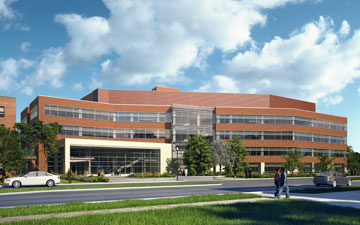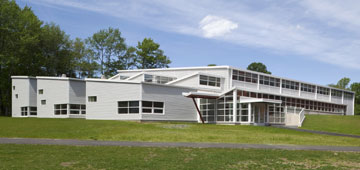Tightening budgets and the need for flexible, multi-use spaces have created a resurgence in the development of multipurpose areas at school campuses. But unlike the multipurpose rooms of old — often built bare bones except for the necessities needed to create a cafeteria/assembly hall/gymnasium and whatever else the space was to serve as — these varied-use buildings of the 21st century incorporate the latest design and construction methods to create spaces that are easily adaptable to required uses.
The benefits of constructing multi-use buildings are easy to see, says Michael Farewell, a partner at Farewell Mills Gatsch Architects, based in Princeton, N.J.
“I think you spend a little bit more money for the flexibility, i.e. the special acoustic treatments in some cases or the screens and walls that make it possible to subdivide the areas,” Farewell says. “But it’s certainly a lot cheaper than building a single-purpose space.”

University of Rochester’s Clinical and Translational Science Building houses a gymnasium, food services area, and faculty club.
FGMA has worked on dozens of multi-use projects over the years and recently designed the $5.8 million, 17,000-square-foot Campus Center at the Princeton Charter School in Princeton, N.J. The PCS Campus Center multi-use building was built by Tocco Construction of Princeton and houses a gymnasium with an area that doubles as a stage, as well as classrooms for performing and visual arts, and music.
“The school was very interested in this space becoming a shared facility for its separate K-4 and 5-8 grade levels,” says Farewell. “The plan was that both parts of the school would use this new building at different times of the day.”
The priority function of the center is as a gymnasium, an area PCS didn’t have in a dedicated space previously, Farewell says. Inside the sub-dividable gym is a stage that doubles as a black box theater. It can be separated from the gym with an acoustic wall to create a classroom and performance space. Elsewhere within the center are three classrooms for arts, music, and general academic use.
“Like a lot of small schools, PCS really needed to maximize the use of their facilities, so a lot of the spaces in this building fill multiple needs,” Farewell says. “The gym is also an auditorium, the stage is also a performance space, and the lobbies are also art galleries and display areas. Having that kind of flexibility and accommodation of multiple uses was really important to them because they have limited facilities.”
“It sort of means you have to look critically in design at everything from acoustics to lighting and storage to make sure it’s all going to fit with their needs,” he added.
To build that type of flexible and accommodating environment, Farewell says the FGMA team designed in moveable partitions and motorized screens, acoustic muffling features, and natural lighting sources for 100 percent of the occupied spaces.
The 8,000-student University of Rochester in Rochester, N.Y., has applied a similar solution as PCS to a different kind of problem: how to create a building that supports the school’s clinical and research programs while providing space for student services, recreation, and food — allowing the school’s students to remain onsite after class instead of having to traverse the university’s sprawling campus to visit the gym or cafeteria.
The solution that is presently under construction is the $76.4 million, 200,000-square-foot Clinical and Translational Science Building, which was designed by Francis Cauffman Foley Hoffman Architects of Philadelphia and Rochester’s Bergmann Associates, and is being built by the locally based LeChase Construction. The building is part of $300 million in new construction and renovations taking place on U of R’s Medical Center campus.
When completed in June 2011, the CTSB will house academic and student service areas integrated to make the building largely self-contained. Inside will be dedicated spaces for dry and computational research; seminar halls and classrooms; food services; a faculty club; resource library; gymnasium with squash and handball courts, weight room, and a half basketball court; and an atrium connecting to the adjacent School of Nursing.
Building in the student services areas to what will largely be an academic science facility was born out of a combination of needs, says Jim Crispino, president at Francis Cauffman and principal architect on the project.

The Campus Center at Princeton Charter was designed with several uses in mind, including arts and athletics.
“First, the present facilities are lacking and the school requires additional space,” Crispino says. “Second is a matter of convenience. The University of Rochester is a sprawling campus, and winters in Rochester can be punishing. I think they average about 14 feet of snow there every winter. So if you don’t have to leave the building, that’s considered advantageous.”
Lastly, he says, the university hopes the new four-story facility will help in recruiting medical students to their programs.
The CTSB project required a unique design approach to build adequate spaces for the facility’s diverse areas, Crispino says.
“CTSB has a lot of departmental offices, which want to be wide open, and bio-informatics areas, which require individual or enclosed offices or cubicles because inside a mathematician or physician is at work,” he says.
“Additionally, the facility houses computational research labs, which essentially want to be an open office environment, as well as seminar and academic rooms, food services, squash courts and weight rooms — all of which demand there own spatial configurations and there own volumes,” he added,
Crispino says that the university saved money by combining its different needs into one building.
“It’s much more efficient to build a single structure if you can bring the diverse programs into that single structure rather than to build separate physical activities centers, student centers, and research and education centers,” he says.
“Traditionally, you would build three different buildings to mimic what is now in the CTSB at University of Rochester.”


